Visit our main Pages
Ringley Group
Block management
Asset Management
Leasehold Guidance
Ringley Law




Block and Estate Management is about the minutia done well: the role of a Managing Agent is technical, administrative, practical and political. It takes joined up thinking to do what we do well as well as sufficient resource to react to whatever is necessary day-to-day.
As a Managing Agent we know our true business is building relationships with people. Our people are empowered and know that they can make a difference to how people feel about where they live. We call our 'Property Manager's 'Relationship Managers’ to embody our values which are to build relationships, add value, and to take the initiative. We lead the market in transparency and focusing on risk, cash, repairs and place making, usually in that order, and was the first Managing Agent to introduce a ' money back guarantee ’.
Being who we are would be impossible without our passionately committed people, whose qualifications we sponsor and who we support professionally to be the best they can be, as achieving a national training award and our Silver IIP status confirms.




Our onboarding team will visit site to catalogue what we need to manage, set up budget templates, benchmark and database key lease clauses, and for complex sites our Facilities Management team will also inspect to understand in detail plant and equipment on site. Ringley Law will set up company and ownership registers all ahead of your nominated Relationship Manager taking over.
Block Management Packages
An online service, like internet banking: we run demands, arrears, service charge accounts & legal admin, you set the budget and upload invoices to pay
How to change Managing Agent
Changing Managing Agent needn’t be daunting, we have a team dedicated to gathering information, benchmarking leases and setting up plant registers
Learn moreRingley’s Top 10 Tips
There’s a lot you need to know to run the service charge properly: politics, law, building pathology, financial accounting, company matters, here’s a few tips
Learn moreCan’t afford a Managing Agent?
We understand the minimum fees of a full block management service may be prohibitive to small blocks – that’s why we created
www.servicechargesorted.co.uk

The Ringley Group is regulated by all three major bodies - Royal Institution of Chartered Surveyors (RICS), the Solicitors Regulation Authority, and the Financial Conduct Authority.






We have professional memberships in The Property Institute, The Association of Rental Living, The Institute of Fire Safety Managers, Chartered Association of Building Engineers.








Site staff are the eyes and ears of the developments we manage, they are fully connected to our customer relationship management systems. The work they do is visible to residents, e.g., day books and end of shift inspections on the Ringley Gateway portal.
We see success as the emotional connection of each resident to where they live, so the task is simple... to empower site teams to make a difference on resident at a time.
We hire and place a range of site staff including: Concierge, Caretakers, Housekeeping, Cleaners, Gardeners, Maintenance Engineers and more…
read more about site staff solutions


"I am the operations manager at Kiin and we have been working with the team at Ringley for over 2 years now developing and implementing a social and wellbeing calendar of activities for residents at Regency Heights. The lettings advisor has been great to work with - responsive, friendly and providing the bridge between residents and activities. She has a good grasp of what the residents enjoy and how to engage with them. Looking forward to our continued relationship."
| Andre Marques 4 days ago |

"Very pleasant and quick response"
| Mystery 187 days ago |

"We have had a problem with noise from the flat above us in Lady Isle House Ferry Court Cardiff. We contacted a Mr Paul Staniforth who immediately became involved and addressed the situation. We really do appreciate what he has done for us and cannot thank him enough. Once again a big thank you to Mr Staniforth. The noise above was intolerable."
| Shane, 2 days ago |
|
|
We work alongside those deploying capital: our VirginLand by Ringley identify sites, our capital markets team work on equity and debt, our Asset Managers act as Employer’s Agent during the build for Project Monitoring. Towards Practical Completion we will be preparing always to mobilse new assets, take plant handover, recruit great teams and lease up fast.
|
|
We work to enhance the value of our Client’s asset and demonstrate good governance. To us this means engaging with leaseholders, residents and other stakeholders to ensure they are engaged with the management of each development.
|
|
Our aim is to make Management Company Directors feel empowered: to us this means 100% transparency and advising them of the options available to support decision making. We know volunteer directors have a day job, so work to delivery what they need in a timely manner and guide them on the decisions we need.
|
|
Within The Ringley Group we have a range of professional practices to enable transactions: Land Find, Valuers, Surveyors, Engineers and of course Ringley Law.
We work closely with official receivers, asset owners, lenders and tax consultants to support property owners throughout each assets lifecycle. |
Ringley is a group of companies. We are a diverse bunch with far reaching expertise in law, engineering, fire surveying and facilities management. Our data-led in-sourced model will save you money and we will listen, understand your goals and get things done. We are innovative and solutions oriented.
As a group of companies we are a diverse bunch with enough experts on board to be a one-stop-property-shop. We listen and align to each Client's goals so each of us knows what needs to be done all the while remaining innovative and solutions oriented - as a team - One Ringley.
The key to our success is our people.

Best places to eat out in Hemel Hempstead

History of Hemel Hempstead

Most prestigious roads in Hemel Hempstead

Things to do in Hemel Hempstead

Cultural Scene in Hemel Hempstead
Hemel Hempstead, located in Hertfordshire just north of London, has a history dating back to the Anglo-Saxon period. The name “Hemel Hempstead” is believed to come from the Old English “Hæmeles Hamstede,” meaning “Hemel’s homestead.” Originally a small market town, Hemel Hempstead developed around its church and marketplace. The town grew steadily due to its location on key trade routes. Hemel Hempstead remained a modest market town until the 20th century when it was designated as one of the new towns to accommodate London’s overspill population, which dramatically changed Hemel Hempstead’s landscape and population.
In the 20th century, Hemel Hempstead expanded rapidly with new housing, shopping centres, and industrial areas built to support the growing community. The new town development transformed Hemel Hempstead into a modern and thriving urban centre. Today, Hemel Hempstead blends its historic market town charm with contemporary living, offering parks, historic sites, and cultural venues. Hemel Hempstead continues to grow while preserving its heritage, making Hemel Hempstead an important town in Hertfordshire’s history and future.
Visit our main Pages
Ringley Group
Block management
Asset Management
Leasehold Guidance
Ringley Law
Hemel Hempstead, a historic town in Hertfordshire, is celebrated for its prestigious roads that showcase stunning architecture and luxurious properties. Hemel Hempstead’s exclusive addresses offer beautiful surroundings and a unique sense of community, making Hemel Hempstead a highly desirable place to live. The charm and history of Hemel Hempstead shine through its most prestigious roads, attracting those seeking elegance and comfort.
Here are some of the most prestigious roads in Hemel Hempstead:
The Boxmoor Estate, Hemel Hempstead – Known for its elegant houses and proximity to picturesque parks, this historic area in Hemel Hempstead is highly sought after.
Chipperfield Road, Hemel Hempstead – Featuring large detached homes and rural charm near the village of Chipperfield, this road epitomizes prestige in Hemel Hempstead.
Bunkers Lane, Hemel Hempstead – Combining countryside views with prestigious residences, Bunkers Lane is a coveted location in Hemel Hempstead.
Green End Road, Hemel Hempstead – Offering luxury homes on large plots, this peaceful road exemplifies the upscale living available in Hemel Hempstead.
The Bourne End Road, Hemel Hempstead – Well-known for its high-end properties and proximity to the countryside, this road is a prime address in Hemel Hempstead.
Leverstock Green Road, Hemel Hempstead – Famous for grand homes and scenic surroundings, this road provides an idyllic setting in Hemel Hempstead.
Long Chaulden, Hemel Hempstead – With scenic views and luxurious properties, Long Chaulden offers an upscale atmosphere in Hemel Hempstead.
The prestigious roads of Hemel Hempstead reflect the town’s rich history and exclusive lifestyle. Hemel Hempstead continues to attract residents seeking beautiful homes, serene environments, and a strong sense of community, making Hemel Hempstead a truly special place to live.
Visit our main Pages
Ringley Group
Block management
Asset Management
Leasehold Guidance
Ringley Law
Hemel Hempstead boasts a wide variety of dining options, offering everything from casual eateries to fine dining experiences. Whether you're craving international flavors or local favorites, there's something to suit every taste.
The Old Town Tavern, in Hemel Hempstead – A cozy pub offering hearty British classics and a great selection of ales.
The Flower Pot, in Hemel Hempstead – A popular gastropub serving seasonal British dishes with a contemporary twist.
Zaza's, in Hemel Hempstead – Known for its delicious Italian cuisine, particularly the wood-fired pizzas.
The Plough & Harrow, in Hemel Hempstead – A traditional pub offering classic British food with a modern flair, perfect for a relaxed meal.
ASK Italian, in Hemel Hempstead – An Italian chain restaurant serving tasty pasta, pizza, and salads in a family-friendly atmosphere.
The Georgian Dragon, in Hemel Hempstead – A stylish pub serving gourmet burgers and inventive small plates, alongside a great range of drinks.
The Royal Bengal, in Hemel Hempstead – An authentic Indian restaurant known for its rich flavors and wide variety of curries.
Spice Hut, in Hemel Hempstead – A casual spot for delicious, freshly made Indian dishes, popular with locals for takeaway and dine-in.
No matter your preference, Hemel Hempstead provides a wide array of excellent dining options that cater to different tastes and occasions. Whether you're looking for a relaxed pub meal or a fine dining experience, the town has something for everyone.
Visit our main Pages
Ringley Group
Block management
Asset Management
Leasehold Guidance
Ringley Law
Hemel Hempstead, l offers a delightful mix of natural beauty, historical landmarks, and family-friendly attractions. Whether you're an outdoor enthusiast, history buff, or seeking fun activities for all ages, Hemel Hempstead has something to offer. Here are some top things to do in Hemel Hempstead:
Gadebridge Park in Hemel Hempstead is a 32-hectare urban park featuring a Roman villa, walled gardens, skate park, cycling paths, and a splash park, making it ideal for outdoor recreation.
The Snow Centre in Hemel Hempstead offers the UK's largest indoor real snow slope, providing skiing and snowboarding lessons, as well as a ringo slide for family fun.
St Mary's Church in Hemel Hempstead is a Grade I listed building with a history dating back to 1140, featuring a 200-foot spire and a memorial to Sir Astley Paston Cooper. en.wikipedia.org
Amaravati Buddhist Monastery near Hemel Hempstead offers a peaceful retreat in the Chiltern Hills, providing meditation workshops and opportunities to learn about Buddhism.
The Bury in Hemel Hempstead is a Grade II* listed neoclassical country house built around 1790, offering a glimpse into the town's architectural history.
Roughdown Common in Hemel Hempstead is a 3.6-hectare biological Site of Special Scientific Interest, offering steep slopes and chalk grassland for nature enthusiasts. en.wikipedia.org
Jellicoe Water Gardens in Hemel Hempstead are restored 1950s gardens featuring scenic routes, flowerbeds, and ponds, providing a tranquil environment in the town center.
Grand Union Canal near Hemel Hempstead is the UK's longest canal, offering scenic walks, cycling paths, and opportunities for boating along its 137-mile stretch.
Magic Roundabout in Hemel Hempstead is a unique traffic junction with multiple mini-roundabouts, offering a distinctive driving experience.
Old Town Hall in Hemel Hempstead is a Grade II listed Jacobean-style building dating back to 1851, serving as a historical landmark in the town center.
Frogmore Paper Mill near Hemel Hempstead is part of the Paper Trail, offering factory tours and exhibits showcasing the town's industrial heritage in papermaking.
The Old Town in Hemel Hempstead features historic buildings, independent shops, and traditional pubs, providing a charming area to explore and shop.en.wikipedia.org
Hemel Hempstead Market is a traditional market offering a variety of goods, including fresh produce, clothing, and household items, held regularly in the town center.
Boxmoor Trust near Hemel Hempstead offers nature reserves and walking trails, providing opportunities for wildlife spotting and outdoor activities.
Hemel Hempstead Museum offers exhibits on the town's history, including its development as a new town and its industrial past.
Hemel Hempstead is a delightful destination that seamlessly blends nature, history, and community spirit, offering a variety of activities for all ages.
Visit our main Pages
Ringley Group
Block management
Asset Management
Leasehold Guidance
Ringley Law
Hemel Hempstead, a charming town in Hertfordshire, boasts a rich and diverse cultural scene that caters to a wide array of artistic interests. From theater productions and live music performances to community festivals and art exhibitions, there’s something to engage everyone. The town is a hub for both local creativity and cultural expression, offering a welcoming environment for visitors and residents alike.
Boxmoor Playhouse in Hemel Hempstead – A community theater offering a range of productions, including plays, musicals, and pantomimes.
The Old Town Hall in Hemel Hempstead – A historic venue that hosts live performances, art exhibitions, and cultural workshops.
Aeolian Singers in Hemel Hempstead – A local choir known for its diverse repertoire and performances throughout the year.
Hemel Hempstead Arts Festival – An annual event showcasing art exhibitions, theater, music, and workshops for all ages.
Windrush 75 Celebration in Hemel Hempstead – A community celebration marking the 75th anniversary of the Windrush generation with music, dance, and storytelling.
Holi Festival of Colors in Hemel Hempstead – A lively and colorful celebration of spring, featuring music, dance, and the traditional throwing of colored powders.
Boxmoor Literature Festival in Hemel Hempstead – A celebration of literature, offering author talks, book signings, and creative writing workshops.
African Heritage, Food & Cultural Photo Exhibition in Hemel Hempstead – An exhibition exploring African heritage through visual art, food, and cultural displays.
The Rex Cinema in Berkhamsted – A short drive from Hemel Hempstead, this independent cinema screens a mix of classic and contemporary films.
Tring Natural History Museum near Hemel Hempstead – A fascinating museum that showcases the natural world with an emphasis on the area's rich history of animal specimens.
Hemel Hempstead offers a rich tapestry of cultural events and venues that celebrate creativity and community. The town’s diverse cultural scene ensures there’s always something interesting to explore and enjoy.
Visit our main Pages
Ringley Group
Block management
Asset Management
Leasehold Guidance
Ringley Law
All content © copyright 2025. Ringley Limited. All Rights reserved. Ringley Limited, incorporated and registered in England and Wales.
Registered office: Ringley House, 1 Castle Road, London, NW1 8PR. Company No. 12416807
Terms of use | Privacy Policy | Modern slavery act | Health and Safety Policy | Anti Bribery and Corruption | COVID-19 risk assessment